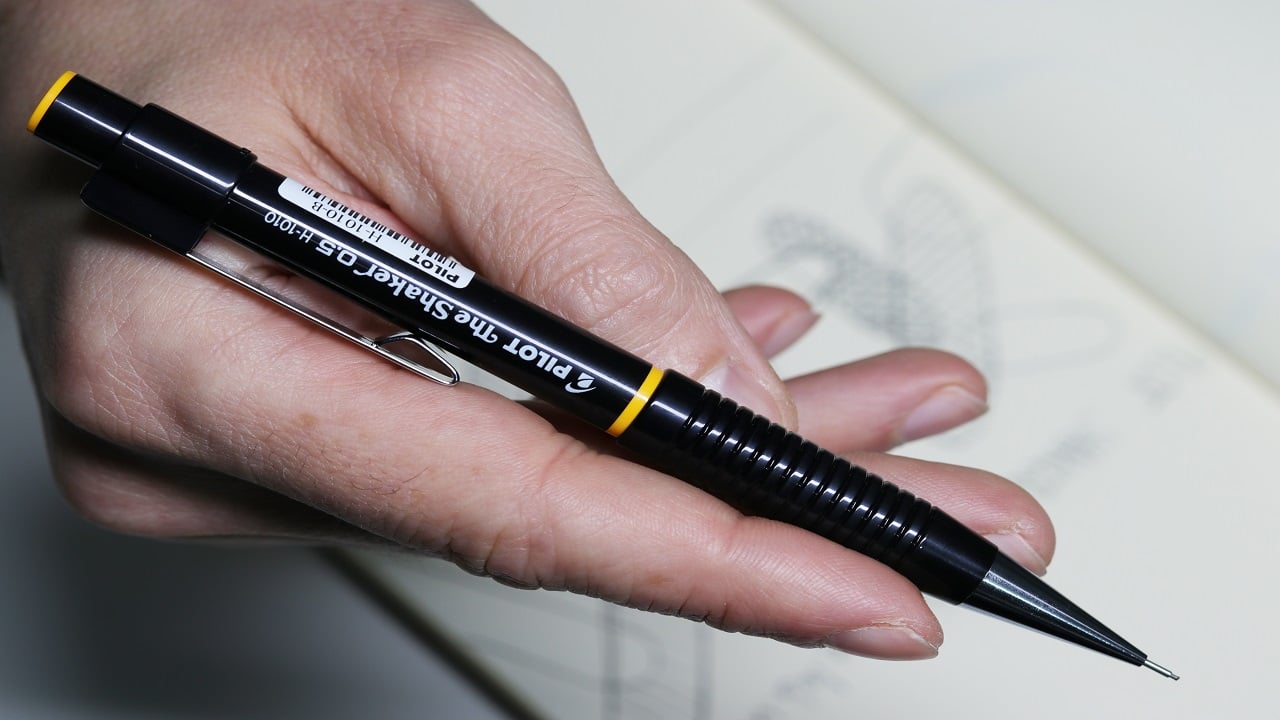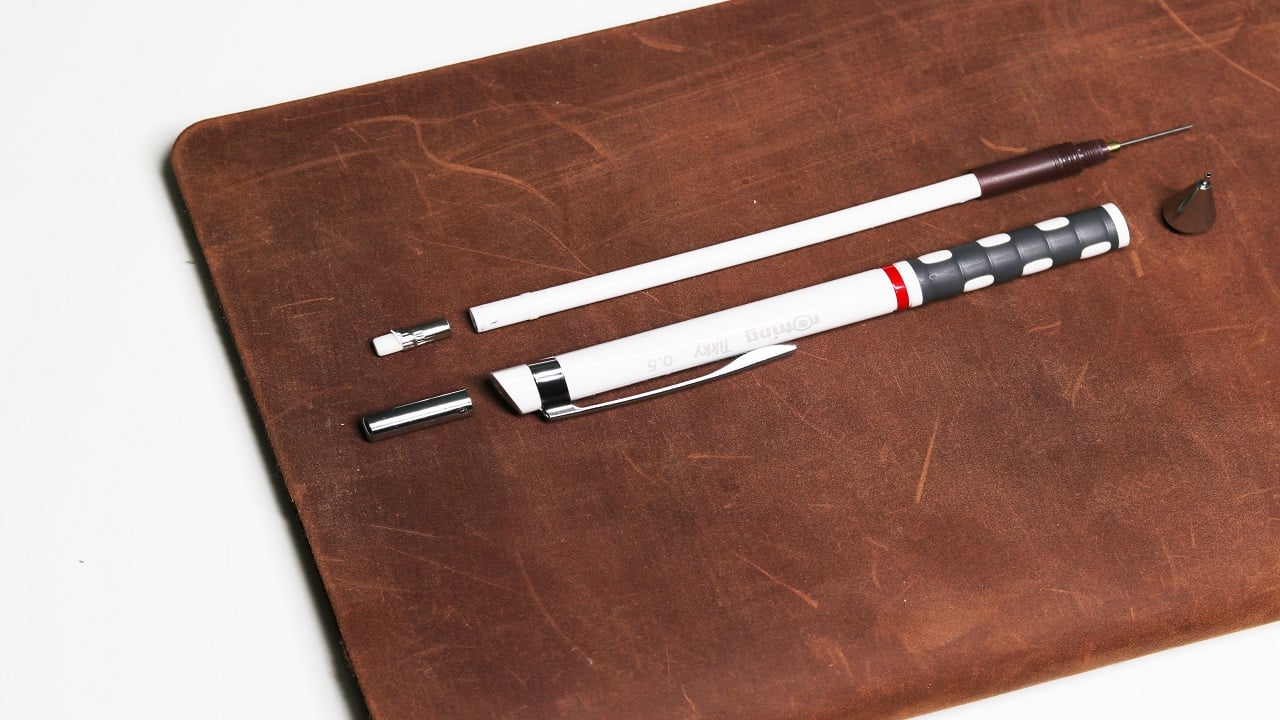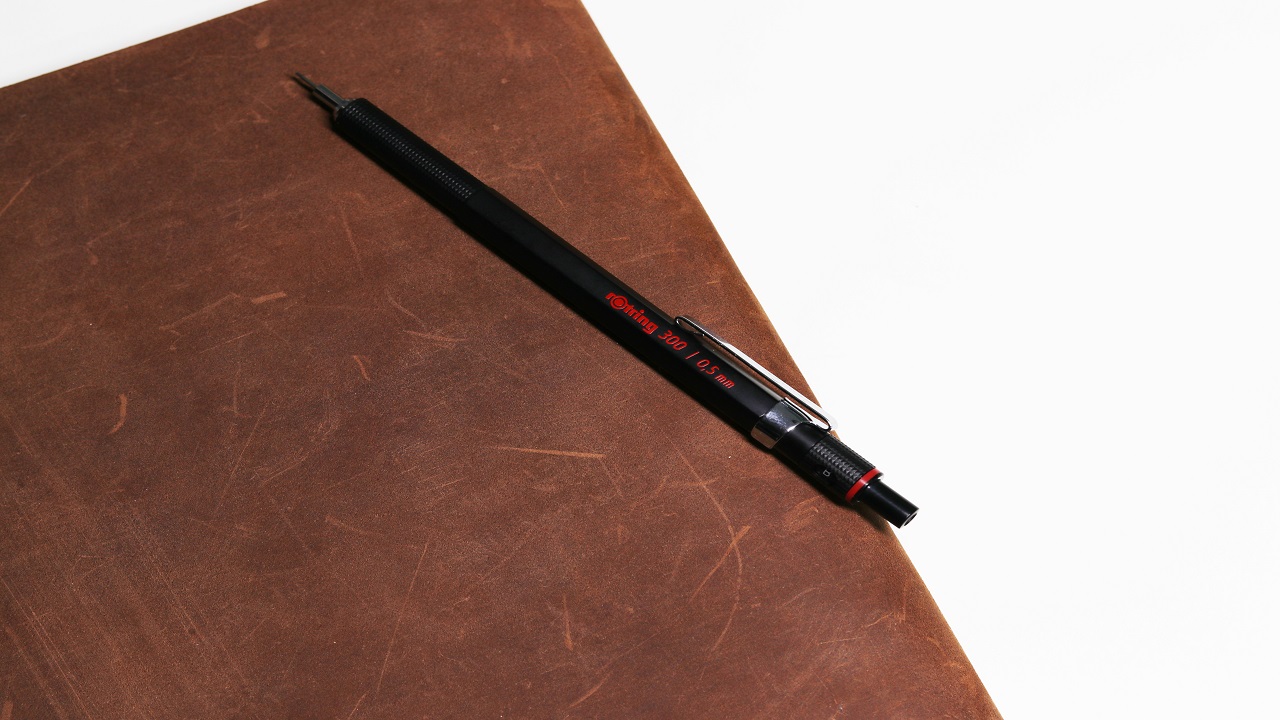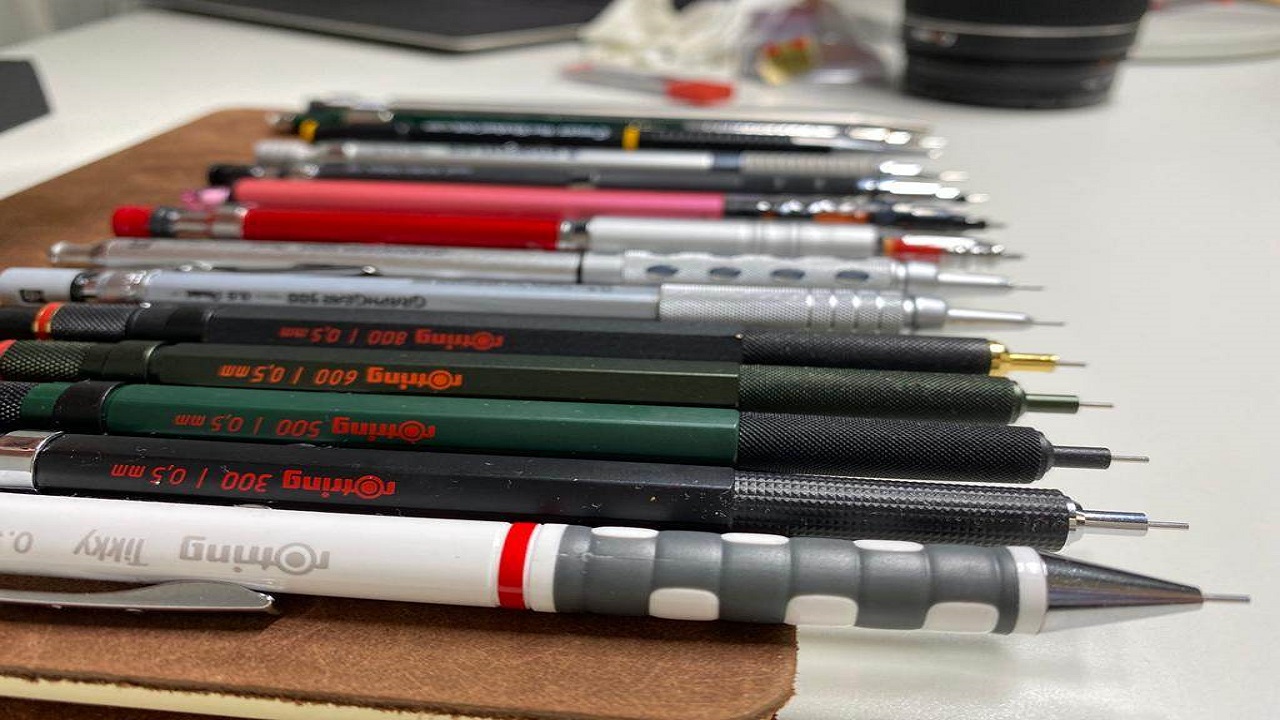If you’re on the hunt for the best mechanical pencils, it is a good idea to learn all you can about them.
This is because it can be quite confusing to choose between various options if you don’t know how these pencils function, their suitable uses, available features, etc. That’s why I’ve decided to put together this comprehensive guide that will walk you through what mechanical pencils are.
So, read it until the end!
What Are Mechanical Pencils?

Mechanical pencils, also known as propelling or automatic pencils, feature a lead advancement mechanism used to advance a thin graphite stick placed within. While this definition encompasses almost all mechanical pencils, different options on the market offer various features and may function differently.
Such pencils are also known as clicky pencils or drafting pencils, though these names are often used for other types of pencils.
The lead of mechanical pencils is available in a few standard sizes, with 0.5 mm and 0.7 mm being the most common, followed by 0.3 mm. Alternatively, some manufacturers offer pencils that support leads of 2 mm, but such pencils are usually categorized as pencil holders.
Drafting pencils are also a subcategory of mechanical pencils; they are sturdy and have unique features like lead grade indicators, knurled grips, etc. On the other hand, clutch pencils are considered to be different from mechanical pencils since they release the lead when you press and hold a button.
Origin And History
Conrad Gessner first published a sketch of a mechanical pencil in 1565, and such pencils used lead around 1.18 mm thick, which was pushed inside them. Before that, lumps of graphite were used along with pieces of cloth wrapped around them. Over time, wooden holders were developed that could hold graphite sticks in place more easily.
The first mechanical pencils were created during the late 1700s and early 1800s and were similar to modern clutch pencils. They also featured a twist mechanism that wrapped the lead like a fastener whenever it was used.
Modern mechanical pencils were invented to meet the need for pencils that could be used with very thin leads to create highly intricate characters, such as those in Japanese scripts. Also, ornate silver sterling decorations were common on mechanical pencils of the time.
One of the first such pencils was the Ever Ready Sharp Pencil, manufactured by Tokuji Hayakawa, and it became so popular that his company adopted the name Sharp. However, it was difficult to produce thinner lead using the clay and graphite mixture used at the time due to its brittle nature.
That is why modern mechanical pencils use leads that contain high-polymer organic materials which can withstand more force and do not break easily.
Other Types Of Pencils
Multifunction Pens
Multifunction pens or multi-pens are writing instruments that usually contain two or more ballpoint refills and may have one mechanical pencil. Generally, this pencil is a gravity select or twist action model, and its lead chamber and mechanism take the place of one of the ballpoint refills.
Such pencils can be used like regular mechanical pencils, and the lead can be extended by clicking the top button. But adding new lead can be a bit complicated since you need to remove the pencil mechanism from its mount.
The tube where the lead has to be inserted can hold two to three leads at a time. Multifunctional pens are best for occasional uses but may not be ideal if you need to use a mechanical pencil frequently.
Woodcase Pencils
Regular wooden pencils are manufactured using a lead core with an outer covering made of wood. In such pencils, the line width can vary drastically over time since the pencil loses its sharpness as the lead wears out with regular use. That is why they need to be sharpened, though frequent sharpening ultimately reduces their size to such an extent that they become practically unusable.
Advantages Of Mechanical Pencils
A Mechanical pencil offers several advantages over a traditional one, such as:
1. Better Balanced
Mechanical pencils, such as the roTring mechanical pencil Tikky, are much better balanced than traditional ones. This is because, in traditional pencils, the balance gets altered as the lead gets used.
2. Reusable
With regular usage, the lead of traditional pencils wears down, which makes the pencil unusable. In contrast, the same mechanical pencil can be used countless times since you can simply replace the lead inside. They only need to be replaced when they get damaged.
3. Consistent Line Width
The width of strokes produced by a traditional pencil varies with use, with newer, sharper pencils creating thinner lines that get thicker as the pencil is used. This is not an issue with a mechanical pencil, and the line width always remains the same.
4. Wide Selection Of Designs
Mechanical pencils are available in a wide variety of designs. They can appear similar to sophisticated instruments, works of art, or even traditional pencils, depending on the manufacturing materials. Also, different pencils offer varying features, such as automatic lead rotation or anti-clogging.
5. No Sharpening Requirements
Unlike regular pencils, mechanical ones do not need to be sharpened, and the lead always has a sharp point for crisp and clean strokes. This also helps save a lot of time and effort, which would otherwise be wasted on sharpening the lead.
How Is A Mechanical Pencil Used?
While there may be some variation in the lead advancement mechanism between mechanical pencils from different brands, their use is quite similar. Many pencils have a system that allows inserting more lead when the one currently being used runs out.
Usually, there is a button at the back end for the purpose, and it needs to be pushed in to retract the lead and insert it into the pencil.
Since more than a single stick of lead is present in a mechanical pencil, you can use the next one by clicking a button if one gets used up. And adding more lead just requires removing the eraser and inserting a lead stick into the hole underneath the cap. Here are some variations of this mechanism.
1. Push Button
This is the most common lead advancement mechanism for mechanical pencils. There is a button, generally at the top of the pencil barrel, which determines how much lead is advanced when the button is pushed. Alternatively, it may be present on the clip or the side.
To install the lead in push-button mechanical pencils, remove the push button or cap, and in many cases, you may also need to remove the eraser underneath. Then add three to five leads in the storage tube but avoid filling the tube completely as that can cause a lead jam.
Replace the eraser and the cap, and push the button, which will allow the leads to come out. To retract the lead in push-button mechanical pencils, you need to hold the button down while pushing the lead inside.
2. Twist And Click
Some mechanical pencils utilize a twist-and-click mechanism for extending the lead, which is similar to ballpoint pens. In this mechanism, you extend the lead by twisting a knob at the top of the nose cone of the pencil. While pencils with this mechanism only hold a single lead at one time, they offer greater control over the lead advancement.
To install new leads in twist mechanical pencils, remove the remaining lead from the pencil tip and insert a new one from the same opening. In some cases, you may need to push the lead until it slides into the internal mechanism of the mechanical pencil.
Twisting and holding the knob allows you to push the lead back in, and such pencils may even open from the middle to allow the insertion of a new lead. The mechanism is placed within an adapter inside the pencil, which has a cap that can be removed to add more leads.
3. Shaker
In the case of pencils with a shake mechanism, you need to shake the pencil vertically to advance the lead. A sliding weight within such pencils pushes the button for lead extension, but generally, such pencils also have a button for the purpose.
For installing the lead, these pencils have a larger top section that acts as the button and has to be removed. And shaker pencils feature a similar mechanism to push back the lead inside as push-button pencils.
4. Continuous Twist
Pencils with a continuous twist mechanism were popular earlier but not so much nowadays. They have a screw mechanism that winds down the lead as it gets used. After finishing the lead, you just need to remove its stub, insert a new lead, and wind it back. Such pencils may hold a single lead, but there is usually a place to store more.
In twist mechanical pencils, twist the nose cone or the knob at the top in the direction opposite to that in which it is twisted to advance the lead. This will help you retract the lead in some pencils, while in others, you will have to push the lead back after twisting.
5. Auto-Feed
In auto-feed pencils, you do not need to stop to advance the lead until one stick is finished, and the next one has to be used. This means the lead is not even visible while writing since it is covered with a plastic cone. When the lead is used up enough, and the pencil cone reaches the paper, it is pushed back.
This happens because a spring inside pushes the cone back and extends the lead without clicking or twisting.
6. Sliding Lead Sleeves
Some pencils have sleeves that are smoothly rounded and can slide up easily. So, while they deliver an experience similar to auto-feed ones, you will need to stop to add more leads. There are two types of pencils with sliding lead sleeves, one where the lead slides up when pushed and another where the sleeve slides up while writing.
7. Kuru Toga
The unique feature of Kuru Toga pencils is that the lead rotates automatically as you write. This prevents it from acquiring a chisel tip, which causes thicker lines; however, the sharp point can catch on the paper.
8. Twist-Extend Erasers
Most mechanical pencils have a small built-in eraser that is best for emergency purposes, but some offer larger ones that come with twisting mechanisms. These can be extended and are ideal for those who need to erase frequently.

How To Retract The Lead Sleeve?
In the case of certain pencils, it is possible to retract the lead sleeve when the pencil is not being used. This is very useful since it prevents the lead from bending and keeps your pencil case or pocket protected. To retract the sleeve, press and hold the button and then press the lead sleeve against a hard surface.
Without removing the pressure, let go of the push button but keep pressing the lead sleeve tip, which will allow you to push the sleeve back inside the pencil tip. When you click the pencil again, the sleeve will come out.
Selecting The Right Lead
When inserting new leads into your mechanical pencil, it is crucial to ensure that the new lead is the same size as the ones that came with the pencil. The reason is that using narrow leads will cause them to fall out of the pencil tip, and wider ones will cause a lead jam.
Many mechanical pencils have the lead size printed on them, which comes in handy in choosing the right lead.
Another thing to pay attention to is the lead grade, which determines the type of marks the pencil makes. HB is the most commonly used grade and can be compared with the American #2 pencil, but there are B and 2B grades also, which create smoother and darker marks.
Finally, you need to consider the product line and the brand, which is another important factor though it has less of an effect than the grade and size.
How To Use The Eraser
The best mechanical pencils usually have erasers at the top, often hidden under the push button or the cap. Alternatively, some pencils come with twist erasers that allow you to retract or extend them by twisting the pencil top.
When the eraser gets worn out, it can be replaced easily by removing it and inserting a new one in its place. Again, it is important to select the right eraser that is compatible with the pencil you are using.
Dealing With Lead Jams
Even if you’re using the best mechanical pencil, there will be times when you may face a lead jam. It usually happens when small lead pieces get stuck inside the clutch mechanism and cause the pencil to stop working. You may not be able to advance the lead, or it may advance but then go back in when the pencil is used.
In such cases, it can be beneficial to know how to fix a mechanical pencil. Fortunately, most manufacturers allow their propelling pencils to be dismantled to deal with lead jams. This can usually be done by removing the tip to access the mechanism.
Once the tip is unscrewed, push the button against a hard surface, which will cause the clutch mechanism to push up. This will provide access to the clutch jaws, which are held shut with a brass ring, so you’ll have to push it down to release them.
As they get released, tap the sides of the pencil to dislodge the lead pieces that may be stuck in the mechanism.
In some cases, it may not be possible to access the mechanism. To clear the lead jam in such situations, hold the pencil with the tip pointing upward, with the button held against your desk. Then, insert a cleaning pin through the tip to remove the lead pieces that may be stuck inside.
The cleaning pin may be present next to the eraser, but some pencils may not include it. If there is no cleaning pin at hand, use a thin wire to clear up the clog, but avoid using anything that is too wide. You can even use a piece of the lead, but be careful because it can break very easily.

Mechanical Pencil Buying Guide
With so many options, you can find a mechanical pencil that perfectly meets your requirements. But for that, you need to consider certain factors, such as what the pencil will be used for, the features that are needed, the price, and more.
In this section, I’ll share some of these factors to make it easier for you to find the best mechanical pencil.
1. Purpose
One of the first things to keep in mind when getting a mechanical pencil is the purpose for which it has to be used. Such pencils are highly versatile and can be used for writing, drawing, drafting, and other purposes.
If you need a mechanical pencil for writing purposes, the lead should be thick enough so that it does not break easily. While 0.5 mm leads are suitable for some people, those with harsher strokes may find 0.7 mm or 0.9 mm leads to be more appropriate.
On the other hand, if you intend to use it for drawing, it is better to go with thicker leads and use softer grade leads for bold marks. Commonly 0.5 mm leads are suitable for most drawing requirements, but 0.3 mm ones are better for details.
2. Mechanisms
The click-button mechanism is the most common among mechanical pencils and is quite simple to use. It is also very reliable, and pencils with such mechanisms can easily last for many years. In contrast, other mechanisms, like the auto-feed and shaker ones, knock the lead forward in just a click.
Because of that, they may be more suitable when you need to take down the minutes of a meeting or take lecture notes during a class.
3. Erasers
Mechanical pencils usually come with an eraser, but their usability varies from one person to another. If you do not need to erase much, the eraser on the back may not be of much use. But people who do need to erase frequently also rely on other erasers for the purpose.
If you use the eraser, it is important to consider its replaceability and size. In most cases, the eraser can be replaced easily, but you should check whether suitable replacements compatible with the pencil are available.
Additionally, keep in mind that due to their small size, such erasers generally do not last long, even when using the best mechanical pencil. So, if you want a durable eraser, look for pencils with erasers that can be extended. These are usually found on mechanical pencils with a twist mechanism.
4. Lead Thickness
Knowing the lead thickness that you use can make it easier to find the right pencil. Pencils from certain brands are available in a single size, but those with more technical designs can be purchased in different sizes.
The type and thickness of lead will determine how a mechanical pencil writes.
You should select the thickness depending on the usage. The most common mechanical pencil sizes are 0.5 mm, 0.7 mm, and 0.9 mm, though you can find options in 0.3 mm and 2 mm sizes. For people with smaller handwriting or those who need to create detailed drawings, thinner leads are better.
On the other hand, if you are a heavy-handed user, thicker lead pencils might be more suitable, such as 2 mm, which is similar to regular wooden pencils. Such pencils do not break easily, so you won’t have to replace lead frequently.
5. Price
When looking for the best mechanical pencil, price is an important consideration to keep in mind. The price can vary widely between brands and models and will determine whether it fits your budget or not. You can get a good-quality mechanical pencil that is affordably priced, but you may need to spend more on specific features.
For instance, pencils with a metal body will last longer than those with a plastic one and hence, tend to be costlier. Similarly, if you want an option that allows faster lead advancement or has an extendable eraser, you’ll have to spend more money.
Mechanical pencils are available in several design options, which also affects their price. They can look like ordinary pencils, technical instruments, or a piece of art.
Tip
The design of a mechanical pencil determines how the pencil will feel in your hand and is an extremely important factor to consider. When looking at the design of a mechanical pencil, make sure to focus on the grip. Some of the best mechanical pencils come with a knurled metal grip, while others may feature a rubber one. The grip affects the balance and weight of the pencil while determining how comfortable it would be to use.

Mechanical Pencil Guide Final Thoughts
Mechanical pencils are incredibly versatile writing instruments that can be used for all sorts of purposes, including sketching, drawing, and more. That is why they are popular among students and professionals like architects and drafters.
Now that you know the nitty-gritty of mechanical pencils, you can decide whether they are worth trying out. Just make sure to keep the various factors mentioned in the buying guide in mind when getting one, which can help you find the right mechanical pencil.
With that, this detailed guide to mechanical pencils has come to an end. And if you enjoyed this, learning how can thermal imaging detect moisture might be an interesting read worth considering!


